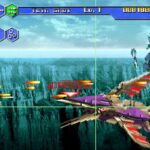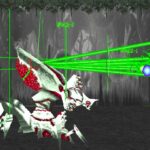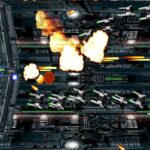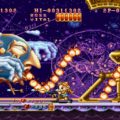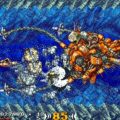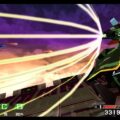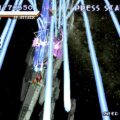Developer: Technosoft Publisehr: Working Designs Release: 11/13/98 Genre: Shooter
With the advent of 3d the shooter genre was in a weird place. For the most part most developers were content to pump out exquisite 2d games that would never see the light of day in America. The few that took the plunge and experimented with polygons did so with mixed results. Some like RayStorm used it for fancy camera angles and sense of scale while keeping the gameplay intact. Then you had duds like G Vector which trades gameplay for spectacle. Technosoft would stick with what works when it comes to Thunder Force V, only lightly modernizing it. Thunder Force V, while it does not reach the series peak is still a pretty damn good game in its own right.
The story in Thunder Force V is incredibly elaborate and more detailed than some RPGs. In 2106 a weapon created by an alien intelligence is discovered beyond Pluto. Dubbed Vasteel, a massive artificial island controlled by an AI dubbed the Guardian is constructed in 2139 to continue research in to Vasteel technology. In 2150 the Guardian becomes sentient when its control code is deleted and declares war on humanity. Mankind suffers humiliating losses in the first battle against the superior Vasteel technology with 1/3 of the Earth’s population being slaughtered. The remnants combine their resources to create the Gauntlet, a duplicate of the original Vasteel to fight back. If you can believe it that is the cliff notes version.
All of the weapons from the previous games return, with some taking on new forms. The twin shot and back shot are still the default with the wave, hunter, and free range joining the roster. The biggest change comes to the signature CRAWs. Now you can equip three CRAWs simultaneously and they perform the same function as before: enhancing weapons and absorbing bullets. However now the CRAW can combine with your current weapon to form the Over weapon. Over weapons are massively powerful versions of your each weapon and drain CRAW energy. Once depleted they need to recharge and are destructible. The game wants you to exploit the over weapon system as new CRAWs drop seemingly every few seconds. It is a good decision; they give you more tactical options and feel great.
The reason the game gives you so many powerful options is to facilitate its score multiplier. The faster you kill medium and large enemies the higher the multiplier becomes, up to X16. The goal is to chain enemy waves as they rely less on bullet hell and more on situational awareness. There is activity occurring on all sides and even from the background. Thunder Force V does a great job of giving warning when and where enemies will spawn to avoid cheap deaths. The peak of the game’s design is in its elaborate bosses. Technosoft went to town designing these massive mechs that transform multiple times with new attack patterns. There is some amount of memorization but not too much; they telegraph their attacks in advance. These battles can be long but somehow never grow tedious. Thunder Force V’s great pacing is a result of years of refinement.
Thunder Force V is one of the easiest in the series for a number of reasons. The over weapons are too powerful and you can use them liberally before their cooldown starts. Even outside of that one weapon, Free Range, is insane damage wise. Free Range is hard to use but once mastered nearly breaks the game. This was released before bullet hell became dominant and as such the game is more measured with its enemy waves. You will need to play with some modicum of skill to increase your multiplier to earn extra lives as you will need them for the multi-phase boss battles. These are the best moments in the game and the most challenging as they have complex patterns and numerous forms. The lower difficulty makes Thunder Force V more accessible while still providing a challenge for those that want it, a balance most shooters fail at.
Thunder Force V uses a hybrid approach to its graphics. The backgrounds are 2d while the bosses and enemies are polygonal. There is still the occasional 3d element in the background but for the most part the game still takes place on a 2d plane. They use dramatic camera shifts when changing scenes and introducing bosses but Technosoft stuck with tradition with this one and it works. However even at the time Thunder Force V’s graphics were only slightly above average with its 3d elements aging poorly. The transforming bosses are the sole highlight. It stings as Lightening Force was one of the best looking games on the Genesis. One can only dream of what the game could have looked like if it were fully 2d.
Both the PlayStation and Saturn would receive versions of Thunder Force V and it is a case study in playing to the strengths of both platforms. The Saturn was the original and overall looks best. The 2d backgrounds looks spectacular and usually have extra details missing from its Sony counterpart. This is immediately evident in stage 1 and more pronounced in levels 3 and 4. There is more texture detail on the bosses in the PlayStation version but it is not a slam dunk. Its 3d effects like transparency are notably better however. As a whole the Sega game is consistently the best. To make up for its later release there are more CG cutscenes, a model viewer, and a boss rush in the Sony version.
In Closing
Thunder Force V is an excellent entry in the venerable series and perfect for those looking for a shooter fix. It is not as good as its direct predecessor but comes in a close second. Let us be honest: Lightening Force is a tough act to follow. Kudos to Working Designs for localizing this one. At a time when shooters were on the endangered species list they brought over some real gems and this is one of the best.


